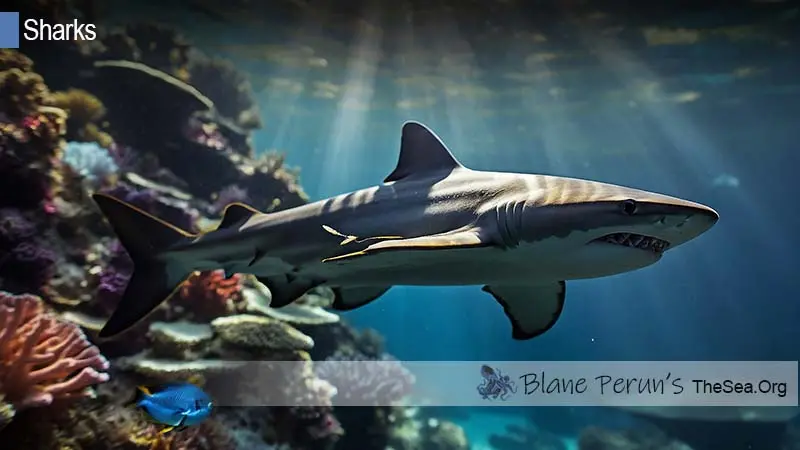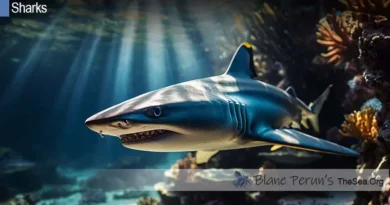What Is A Shark
Sharks are certainly among the most diverse and most populous groups of aquatic creatures. They are varied in terms of size, diet, temperament, growth rate, even in terms of habitat choice, so it is probably easier to list features that are specific for each shark species than to find common traits, but there are some traits that all of them share.
Sharks are so called apex predators – top predators at the top of the aquatic food chain, with an important role in regulating the populations of the species that are below them – that inhabit all the seas and oceans of the world and live in some of the world’s rivers and estuaries, too. Understanding the diverse range of shark species and their habitats is crucial for conservation efforts, as each species plays a unique role in its ecosystem. From the shallow coral reefs to the deep-sea trenches, these habitats offer different conditions that support various shark species, influencing their behaviors, feeding patterns, and reproductive strategies. Protecting these environments is essential for maintaining the ecological balance and ensuring the survival of these remarkable creatures.
All sharks share a number of physical features:
All sharks have skeletons made of cartilage, a tissue that is not as rigid and heavy as bones and allows sharks to move more freely and be more resilient;
All sharks breathe through gills;
They all use a process called osmoregulation to keep the amount of salt in their body at certain levels and to prevent the fluids in their body from becoming too diluted or too dense. They use their gills to achieve this balance.
They all have multiple rows of teeth – teeth that they lose and re-grow regularly;
All sharks have very good eyesight and their sense of smell is also excellent;
These features are more related to anatomy and not so much to size, shape, habitat or behavior – the 500 different shark species known today vary so largely in terms of physical appearance and habits that they need a more complex classification system.
There are numerous features that make sharks truly special and peculiar – here are just a few:
A shark’s denticles – which are tooth-shaped scales – make it possible for it to swim fast through the water without collecting algae deposits and barnacles, making them almost completely free of parasites;
Sharks have their own built-in toothpaste – the exterior of sharks’ teeth is made of fluoride, a substance frequently used in toothpaste;
Sharks tan too – some hammerheads are known to swim near the surface of the water to get tanned because darker skin means better camouflage.
Sharks first evolved about 450 million years ago, but they kept developing for another 140 million years, until their body design became as we know it today. The oldest evidence about the existence of sharks dates back to before vertebrates developed and, according to paleontologists, the ancient shark looked very different from what sharks look like today: it was only about 1 meter long, it had inflexible, triangular fins, slim jaws and teeth that had pointed ends. There is evidence that sharks lived in freshwater initially – it was only about 220 million years ago that they took to the sea and conquered it. Modern sharks date back to only about 100 million years, the white shark being one of the oldest species living today.
What Is A Shark?
Dive into the depths of the ocean, and you’ll find one of the most formidable predators that has fascinated humans for centuries: the shark. These creatures, belonging to the group Elasmobranchii, which also includes rays and skates, have roamed the Earth’s oceans for over 400 million years. With over 500 species ranging from the tiny dwarf lanternshark to the colossal whale shark, sharks boast an incredible diversity. They are not just ruthless hunters as often portrayed; sharks play a crucial role in maintaining the balance of marine ecosystems. Their anatomy, behavior, and survival strategies make them one of the most intriguing subjects in marine biology and beyond. Research into the lifespan of different shark species reveals significant variations, with some species living only a few decades while others, like the Greenland shark, can surpass 400 years. Understanding these longevity patterns not only enhances our knowledge of shark biology but also informs conservation efforts aimed at protecting these ancient mariners. As apex predators, sharks help control the populations of other marine species, highlighting the importance of their preservation in the face of environmental changes and human impact.
Anatomy and Physiology of Sharks
Understanding Shark Skeletal Structure
Sharks are known for their cartilaginous skeletons, which are much lighter and more flexible than bone. This unique feature, composed of a tough material called chondroitin, allows for the agility and speed sharks are famed for. Unlike bony fish, sharks’ skeletons do not calcify, enabling them to grow larger and heal faster from injuries. Their skin, covered in dermal denticles, reduces friction as they glide through water, contributing to their efficiency as apex predators. Interestingly, one might wonder how many bones are in sharks, and the answer is none—sharks are entirely composed of cartilage. This absence of bones not only aids in buoyancy but also provides advantages in their hunting strategies, allowing for quick bursts of speed and abrupt changes in direction. Their evolutionary adaptations have made them unparalleled hunters in marine environments.
The Remarkable Sensory Systems of Sharks
Sharks possess an array of sophisticated sensory organs that make them excellent hunters. The lateral line system, a network of fluid-filled canals on their bodies, detects vibrations and movements in the water, alerting them to potential prey. Additionally, sharks have ampullae of Lorenzini, electroreceptor organs that allow them to sense the electric fields generated by the muscle movements of other organisms. Their keen sense of smell, capable of detecting a single drop of blood in millions of drops of water, is also noteworthy. Sharks also communicate through a variety of methods that include shark vocalizations and sounds, which can indicate distress or serve to establish territory. These auditory signals, while often imperceptible to human ears, may play a crucial role in their social interactions and mating behaviors. Together with their impressive sensory capabilities, these vocalizations enhance their efficiency as predators in diverse marine environments.
Shark Behavior and Diet
Predatory Tactics and Feeding Habits
Sharks are known for their diverse feeding strategies. Species like the great white shark (Carcharodon carcharias) use their powerful jaws and sharp teeth to prey on large mammals and fish. Others, like the basking shark (Cetorhinus maximus), are filter feeders that consume plankton. Their hunting techniques can be highly specialized; for example, the thresher shark uses its long tail to stun fish before consuming them. In contrast to the aggressive predation of the great white, the whale shark (Rhincodon typus) showcases a different approach to feeding, primarily relying on its size and filter-feeding capabilities. When examining whale shark characteristics compared to great white, it’s clear that the former is known for its gentle nature and massive frame, making it the largest fish in the ocean. This unique adaptation enables the whale shark to thrive in environments rich in plankton, setting it apart from its more formidable relatives.
Social Behavior and Migration Patterns
Contrary to popular belief, not all sharks are solitary hunters. Some species, like the scalloped hammerhead (Sphyrna lewini), form large schools during migration. Sharks’ migration patterns are often linked to breeding or feeding grounds and can cover thousands of miles. Understanding these patterns is crucial for studying shark behavior and ensuring their protection. These schools can consist of hundreds of individuals, showcasing the social nature of these creatures. Furthermore, the dynamics within these groups can vary significantly, with researchers studying the groups of sharks terminology to better understand their interactions and social hierarchies. This knowledge is essential not only for conservation efforts but also for fostering greater appreciation of these magnificent animals.
Shark Habitats and Adaptations
The Diverse Ecosystems Sharks Inhabit
Sharks are found in all of the world’s oceans, from shallow coastal waters to the deep sea. Each species has adapted to thrive in a specific habitat. For instance, the Greenland shark (Somniosus microcephalus) lives in cold Arctic waters, while the tiger shark (Galeocerdo cuvier) prefers warm, tropical seas. Their ability to adapt to a wide range of environments is a testament to their evolutionary success. In addition to these remarkable adaptations, various shark species in the Mediterranean have developed unique characteristics to survive in the region’s diverse ecosystems. The Mediterranean Sea is home to both resident species, such as the endangered shortfin mako shark (Isurus oxyrinchus), and migratory species that travel through its waters. This dynamic environment highlights the importance of conservation efforts to protect these ancient predators from overfishing and habitat loss.
Evolutionary Adaptations for Survival
Over millions of years, sharks have evolved various adaptations that have ensured their survival. Their reproductive strategies, for example, vary greatly among species, from laying eggs (oviparous) to live birth (viviparous). Some species, like the hammerhead, have uniquely shaped heads that improve their ability to find prey. These adaptations highlight the evolutionary prowess of sharks in the marine world.
In conclusion, sharks are far more than the menacing predators often depicted in media. They are complex, fascinating creatures that play a vital role in marine ecosystems. Their diverse species, intricate anatomy, and sophisticated behaviors make them a subject of endless interest and importance in marine biology and conservation. As we strive to protect these magnificent animals, it is crucial to understand their current status in the wild and how many sharks are remaining. The alarming decline in shark populations due to overfishing and habitat loss highlights the urgent need for conservation efforts. By raising awareness and promoting sustainable practices, we can help ensure that future generations will continue to marvel at these remarkable beings.
FAQs about Sharks
What is the largest species of shark?
The largest shark species is the whale shark (Rhincodon typus), which can grow up to 60 feet in length. Despite their size, whale sharks are gentle giants, feeding primarily on plankton through filter feeding.
How do sharks reproduce?
Shark reproduction varies by species. Some sharks lay eggs in protective cases, known as oviparity, while others give birth to live young, referred to as viviparity. There are also species that have a combination of these methods, known as ovoviviparity, where eggs hatch inside the female, and the young are born live.
Can sharks really smell a drop of blood from miles away?
While sharks have an extremely acute sense of smell, the idea that they can detect a single drop of blood from miles away is an exaggeration. They can detect small amounts of blood in water, but this ability is more localized and not as far-reaching as popularly depicted.
Why do sharks attack humans?
Shark attacks on humans are extremely rare and often a case of mistaken identity. Sharks might confuse humans with their usual prey, like seals, especially in murky waters or low visibility conditions. Most sharks are not aggressive towards humans unless provoked.
Are all sharks dangerous to humans?
No, not all sharks are dangerous to humans. Out of over 500 species of sharks, only a handful are involved in incidents with humans. The majority of sharks pose no threat to humans and avoid contact whenever possible.



